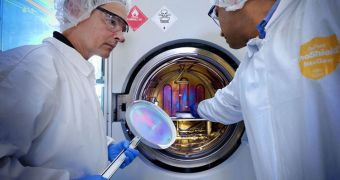Researchers at the NASA Goddard Space Flight Center (GSFC), in Greenbelt, Maryland, and the University of Maryland in College Park, are currently working on a new shielding material, destined to protect spacecraft and the International Space Station from micrometeorites.
These small chunks of space debris are impossible to detect even with the most advanced radars. They permeate Earth's orbits, and can reach top speeds of 20 kilometers (12.4 miles) per second. Such a high speed enables them to produce significant damage when they impact vehicles.
Equipment such as optics, detectors, and solar panels are naturally the most sensitive. The ISS is currently outfitted with micrometeorite shields, but they are slowly being destroyed by the impacts. Such small objects once nearly pierced a shuttle window.
The joint research team decided to create the new shielding material because no protection method available today is capable of stopping 100 percent of all micrometeorites. The stuff now under development very well could.
GSFC expert Vivek Dwivedi and UMCP chemical engineering professor Raymond Adomaitis are working on next-generation protective coating, made up of boron nitride nanotubes. The super-strong, ultra-thin coating can only be produced via a method known as atomic layer deposition (ALD).
Though relatively new, ALD is a fast-evolving technology, which is now being used to coat plastics, Teflon, glass, semiconductors and many other materials. From the outside, boron nitride nanotubes resemble the bristles on a toothbrush, experts say.
“Crystalline boron nitride is one of the hardest materials in the world,” Dwivedi explains. Therefore, it could protect sensitive components against the effects of space dust, tiny rocks, and high-energy solar particles, he adds.
In the future, this method may be used to deposit this material on other surfaces as well. “'This ALD application has profound possibilities for the next-generation crew modules. We could decrease the thickness of the glass windows without sacrificing strength,” Dwivedi adds.
Another advantage of atom-by-atom deposition is that the technique – although very complex – is quite inexpensive to apply at a large scale, especially compared to current alternatives.
“This technology can coat anything. It is perfect point-to-point. There are so many applications for this technology. The only thing limiting its use is your imagination,” Dwivedi concludes.

 14 DAY TRIAL //
14 DAY TRIAL //